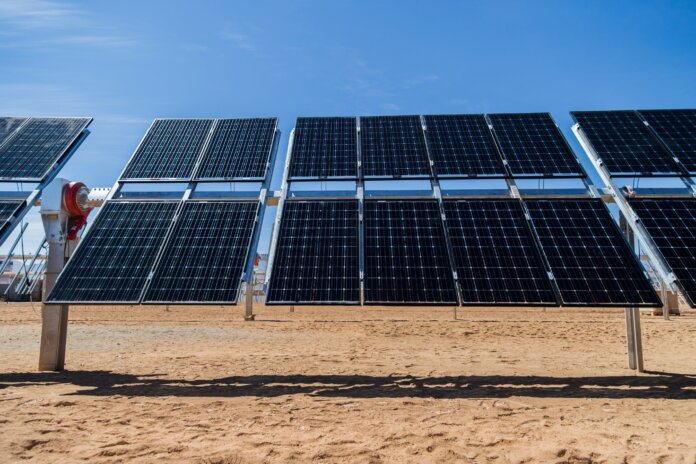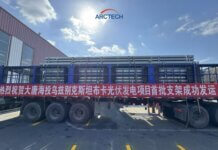Module mounting structures for solar PV systems are mostly found in two flavors: fixed-tilt and tracking. While fixed-tilt systems require lower capital expenditure, need less maintenance and are more reliable, tracking systems can increase the energy yield of a project by increasing the irradiation received by the PV modules as they track the sun through the day. The increased cost, maintenance and risk of failure are generally worthwhile in regions that receive sufficient irradiation. Consequently, trackers are the standard in most utility-scale solar PV applications across medium- and high-irradiation areas.
Although widely adopted, trackers are not immune to failures – particularly when it comes to wind and weather-related events. Indeed, industry webinars on the topic reveal nearly 70% of attendees thought that wind and other weather-related events were the greatest source of issues related to single-axis solar trackers.

Detailed information on tracker failures is not readily shared by manufacturers, since most are reluctant to disclose failures associated with their products. However, anecdotal evidence from installers and developers aligns with historic case studies and general industry knowledge that identifies key risk factors as localized wind events, dynamic design type and phase of construction.
Failures can be categorized as a failure to perform under wind conditions reasonably expected (design failure) or exposure to wind events outside of conditions reasonably anticipated (extreme weather). Both issues result in increased risk and/or cost to the project owner.
Extreme weather risks are generally not covered through design alone. While robust designs for extreme events are achievable, the additional materials required make the systems commercially unattractive. Therefore, residual risks relating to extreme weather are generally covered through insurance. Insurance policy terms and cost are typically affected by the geography and meteorological history of the site, track record of manufacturers and models, the maintenance commitments in project contracts, contractor reputation and warranty coverage.
Considering design failure, projects have historically relied upon design compliance with codes and standards that are not specific to solar trackers. Dependence on these codes has been misleading, indicating suitability where it was not warranted.
In the absence of specific codes, each project, developer, or engineering, procurement and construction contractor may each define their own design requirements. Tracker manufacturers may execute their own studies and meet project requirements, yet the designs remain insufficient to assess and describe tracker behavior under all conditions that may be experienced on site during the lifetime of the project.
Although the industry has recognized this issue for some time, a satisfactory stage of evolution has not yet been reached. Accordingly, the industry has witnessed numerous public tracker failures resulting from conditions under operational thresholds.
Market standards are improving, but development occurs in private. Therefore, progress tends to be slow. Specific design codes for trackers do not yet exist. In fact, specific design codes are not expected until 2022 at the earliest. Making matters more challenging – according to some schools of thought – is that design codes may be difficult to develop and apply.
Until widespread adoption of specific design codes are industry standard, project owners and prospective project owners need to be aware of the associated risks for trackers and consider the following mitigation options:
- Understand that not all industry players are equivalent – some may not be motivated to adhere to best standards.
- Seek an experienced developer and EPC contractor with expertise in tracker construction and operation.
- Pursue a tracker manufacturer that can demonstrate an extensive successful track record in the region of your project, and seek appraisal of their product by an independent specialist.
- Complete a project design review, including whether site-specific meteorological campaigns have occurred, the inclusion of campaign and site findings into the design, and adherence to independent study conclusions.
- Product design review, including assessing the validity of testing and designs, stow strategy and response times, static dynamic and aeroelastic testing considering full 3D multi-row testing, and bankability report review.
- Review the completion of independent factory acceptance testing, construction monitoring and commissioning.
- Examine the tracker supply contract, focusing on liquidated damages, acceptance tests, defect liability periods, defect and serial defect provisions, warranty provisions and force majeure definitions.
- Explore insurance options to cover construction phase and/or operational phase perils.
- Seek an independent engineer who can support you in project acquisition or operation.
Luke Boyden is a principal with The Renewables Consulting Group, an integrated market intelligence, management consulting and technical advisory firm. RCG most recently supported technical due diligence efforts for 230 MW of solar projects in Brazil that use horizontal single-axis trackers. Boyden can be reached at luke.boyden@thinkrcg.com
Photo: Soltec tracking technology on a project in Brazil





Snow load + wind load are the top solar killer!
Even more so for tracking.
But tracking usually allows snow dumping by a stow position that is vertical.
It then is more vulnerable from side winds in that direction that has most cross section. Twisting the base 90 degrees will help but only if wind is constant direction.